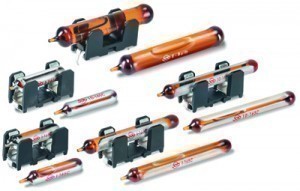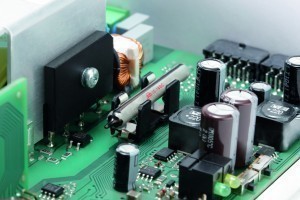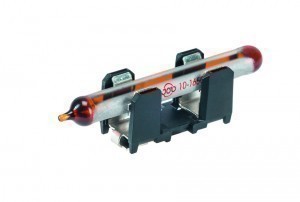With its latest product E-Bulb, JOB has launched the smallest fire extinguisher in the world: the fire extinguishing fuse is suitable for mounting on printed circuit boards and thus opens up new possibilities for device-integrated fire protection. The following article is based on information and documents provided to the author by Markus Fiebig, Business Development Manager for device-integrated fire protection at JOB GmbH, Ahrensburg.
Founded in 1971, JOB GmbH, a 100% privately financed company, is the global market leader in thermal ampoules for sprinkler systems and the automotive industry. It sells more than 110 million glass ampoules per year. There are now over 1.5 billion sprinkler bulbs actively in the field and to date the component failure rate in the event of a fire is 0. With its latest product E-Bulb, JOB has launched the world's smallest fire extinguisher on the market. The E-Bulb fire extinguishing fuse is suitable for mounting on printed circuit boards and thus opens up new possibilities for device-integrated fire protection.
Avoiding fires to prevent property damage and personal injury
The following data, among others, show that fire protection measures are generally necessary and that device-integrated fire protection also makes sense for electrical and electronic devices:
- According to the German Insurance Association (GDV), around one in three fires is caused by electricity, predominantly in electrical appliances, systems and installations.
- In Germany, fires cause an average of around 400 deaths and millions of euros worth of property damage every year.
- The trend towards smart products is increasing the risk of fire, as not only are there more and more electrical devices every year, but they are also permanently online and live so that they can be operated remotely.
'Statistically speaking, there is a fire in a hospital once a week...'
Fires are existential risks for companies: In addition to the danger to people's health and lives, there is the threat of enormous material losses such as production facilities, materials and products, as well as consequential costs due to fire-related environmental damage and the loss of customers and market share. According to GDV statistics, a large-scale fire means the complete end of business for over 40% of the companies affected. Only around one in four companies can fully resume their business activities after a fire restoration.
Fires are existential risks for companies: In addition to the risk to people's health and lives, there is also the threat of enormous material losses such as production facilities, materials and products, as well as consequential costs due to fire-related environmental damage and the loss of customers and market share. According to GDV statistics, a large-scale fire means the complete end of business for over 40% of the companies affected. Only around one in four companies can fully resume their business activities after a fire restoration.
Sprinkler systems and device-integrated fire protection complement each other
Sprinkler systems are primarily used to prevent fires or to fight fires in company and public buildings as well as in industrial plants. Practice has shown that sprinkler systems are very effective in fighting fires. However, their use is also associated with problems. This is because sprinkler systems only trigger automatically in the event of a fire when the fire has already reached such an extent that the specified triggering temperature is exceeded. The cost of using a sprinkler system depends on the use and location of the building as well as the materials and products located there. Expensive equipment for the provision of extinguishing water and/or the retention of extinguishing water may be required. In addition, the extinguishing water from the sprinkler system can also impair or even destroy existing equipment, machinery, materials and products. However, in the event of a fire, this collateral damage is often significantly less expensive than a wildfire. The sprinkler system usually limits the extent of damage to the area where the fire started and keeps the fire small until the fire department arrives. The fire is often extinguished completely by the sprinkler system.
In addition to sprinkler systems as the most important element of active system-based fire protection, device-integrated fire protection systems have become increasingly important in recent years. These serve to fight a fire at its source so that it cannot spread from there. Device-integrated fire protection therefore complements the fire protection system.
The combination of device-integrated fire protection with a sprinkler and fire alarm system is ideal in terms of a holistic fire protection concept. If, under special circumstances, the device-integrated fire protection is unable to extinguish a fire or prevent it from spreading, the sprinkler and fire alarm systems are used.
The first fire protection associations, such as the German Institute for Preventive Fire Protection (DIvB), have adopted device-integrated fire protection as a focus topic due to its advantages.
Fire protection for electrical and electronic appliances
There are many causes of fires in electrical and electronic devices: overload, voltage fluctuations, ESD damage, environmental conditions, component failure, ageing, cold soldering points, corrosion, manufacturing defects, etc. These must be taken into account in the fire protection concept. This must be taken into account in the fire protection concept. Integrated fire protection for electrical and electronic devices is now part of the holistic fire protection concept.  Small fire extinguishing systems for integrated fire protection
Small fire extinguishing systems for integrated fire protection
In addition to passive measures - such as the use of non-combustible or self-extinguishing materials, which has been practiced for many years - there are now also active solutions for device-integrated fire protection in electrical and electronic devices, both for the entire device and for individual electronic assemblies or circuit boards. These small fire extinguishing systems actively fight fires while they are still small and have not yet spread to the area surrounding the source of the fire.
Device-integrated fire protection manages with small quantities of extinguishing agent and therefore requires comparatively little space, as the extinguishing agent is stored directly where the fires typically start, namely in:
- Power supply units, directly on the circuit board
- switch cabinets
- Electrical and electronic devices
Small fire extinguishing systems - can be placed anywhere and are effective - even on circuit boards
 Printed circuit board assembly with E-BulbDependingon the place of use, the size of the extinguishing agent container of these small fire extinguishing systems varies from that of a small fire extinguisher to components that are only slightly larger than a 12 V DC fuse. The latter are suitable for mounting on printed circuit boards.
Printed circuit board assembly with E-BulbDependingon the place of use, the size of the extinguishing agent container of these small fire extinguishing systems varies from that of a small fire extinguisher to components that are only slightly larger than a 12 V DC fuse. The latter are suitable for mounting on printed circuit boards.
They work with chemical extinguishing agents so that no residues are left on the products. In addition, they are neither electrically conductive nor corrosive, so that electronics are practically not damaged.
In higher doses, however, the extinguishing agents can pose a risk to people. Due to the small quantities and the use on electrical circuits or electronics that are installed in control cabinets or devices, i.e. enclosed in a housing, health risks are avoided. The extinguishing agent is released at the source of the fire, takes effect in fractions of a second to a few seconds and is then diluted by the surrounding air. It is not known that anyone has been harmed by the extinguishing agent of a device-integrated fire protection system.
Initially, device-integrated fire protection systems were mainly installed in control cabinets and larger systems. Now they are being used in more and more applications such as large LED displays in fire safety-critical environments such as airports, in medical, military and railroad equipment as well as in industrial and household appliances. Device-integrated fire protection using small fire extinguishing systems can now be implemented in all types of electrical appliances. For preventive risk minimization, this is particularly important for devices that are permanently connected to the power grid, such as computers, routers, telephone systems, televisions and other smart devices, including coffee machines. Device-integrated fire protection systems therefore have the potential to be used across the board in the future, both in private households and in industry, thus further increasing safety.
Thermal ampoules and fire-extinguishing fuses - miniaturized fire extinguishers for electrical appliances
JOB's solution for the control cabinet is the AMFE (Automatic Miniature Fire Extinguisher).  E-Bulb size 5 x 40 mm for SMD mountingTheAMFE consists of a trigger head with a thermosensitive ampoule, as used in sprinkler systems, and a connected extinguishing agent cylinder.
E-Bulb size 5 x 40 mm for SMD mountingTheAMFE consists of a trigger head with a thermosensitive ampoule, as used in sprinkler systems, and a connected extinguishing agent cylinder.
It works as follows: Due to the rising temperature during a fire, an overpressure builds up in the thermal ampoule. Once a defined temperature has been reached, the ampoule bursts, triggering a spring mechanism that opens the (previously closed) cylinder. The extinguishing agent flows out and extinguishes the resulting fire in just a few seconds.
Different sizes and variants of the AMFE are available, e.g. with signal connections for monitoring and messages. The AMFE miniature fire extinguishing unit is MPA and TÜV-tested and works independently. It can also be retrofitted into existing systems, and JOB's solution for electronic assemblies and power supply units is the E-Bulb. This is the smallest fire extinguisher in the world. The E-Bulb fire-extinguishing fuse is mounted directly on the circuit board. In the event of a fire, it irreversibly interrupts the current, extinguishes the fire and prevents re-ignition. Bodo Müller, Managing Director of the JOB Group The Association of German Property Insurers (VdS) and UL have recognized the E-Bulb, which is a mini glass ampoule filled with the high-tech liquid NOVEC from 3M. NOVEC is a C6 fluoroketone with the chemical formula CF3CF2C(O)CF(CF3)2. It is a non-toxic, non-conductive extinguishing liquid that has no corrosive effect and leaves no residue. It is released when the trigger temperature is reached, causing the thermal vial to burst. The fire is extinguished by releasing the contents. NOVEC extinguishes by cooling below the ignition point and this happens almost instantaneously. At the same time, the bursting of the E-Bulb interrupts the power supply via the ampoule, preventing re-ignition. The glass surface of the E-Bulb has an electrically conductive coating so that - when intact - it can withstand currents of up to 16 A at normal mains voltages, which is sufficient for many power supply units.
Bodo Müller, Managing Director of the JOB Group The Association of German Property Insurers (VdS) and UL have recognized the E-Bulb, which is a mini glass ampoule filled with the high-tech liquid NOVEC from 3M. NOVEC is a C6 fluoroketone with the chemical formula CF3CF2C(O)CF(CF3)2. It is a non-toxic, non-conductive extinguishing liquid that has no corrosive effect and leaves no residue. It is released when the trigger temperature is reached, causing the thermal vial to burst. The fire is extinguished by releasing the contents. NOVEC extinguishes by cooling below the ignition point and this happens almost instantaneously. At the same time, the bursting of the E-Bulb interrupts the power supply via the ampoule, preventing re-ignition. The glass surface of the E-Bulb has an electrically conductive coating so that - when intact - it can withstand currents of up to 16 A at normal mains voltages, which is sufficient for many power supply units.
JOB offers customers design-in support for the E-Bulb: experts (chemists, electricians, physicists) with special know-how offer comprehensive support including fire tests and provide design advice (installation position, convection, fire compartments). This means that nothing stands in the way of you getting started with modern fire protection on electronic assemblies. Fire protection with fire-extinguishing fuses is now the order of the day and will soon also be a feature of electronic assemblies - at least for operation in critical environments. -gk-
JOB Group donates device-integrated fire protection technology for 100,000 ventilators
 The world's smallest fire extinguisher in the hands of a firefighter in front of a ventilatorTheGerman JOB Group is offering ventilator manufacturers the opportunity to equip all devices required during the coronavirus crisis with integrated fire protection free of charge in order to safeguard the critical infrastructure in medical facilities. In addition, a design-in team from the manufacturer is available to support device manufacturers with the technical implementation so that the fire-extinguishing safety devices, known as e-bulbs, can be installed as quickly as possible.
The world's smallest fire extinguisher in the hands of a firefighter in front of a ventilatorTheGerman JOB Group is offering ventilator manufacturers the opportunity to equip all devices required during the coronavirus crisis with integrated fire protection free of charge in order to safeguard the critical infrastructure in medical facilities. In addition, a design-in team from the manufacturer is available to support device manufacturers with the technical implementation so that the fire-extinguishing safety devices, known as e-bulbs, can be installed as quickly as possible.
"Especially in these times, when our healthcare system is so urgently challenged, incidents such as a major fire caused by a lack of safety precautions in technical devices would be a disaster. Statistically speaking, there is a fire in a hospital once a week and the source of these fires is often electrical equipment. The JOB Group will therefore make its technology and experience available free of charge in order to effectively protect the new ventilators against fires," says Bodo Müller, Managing Director of the JOB Group. He and his team would like to make a positive contribution to overcoming this crisis and is calling on established manufacturers of ventilators in particular to accept the offer of help.


